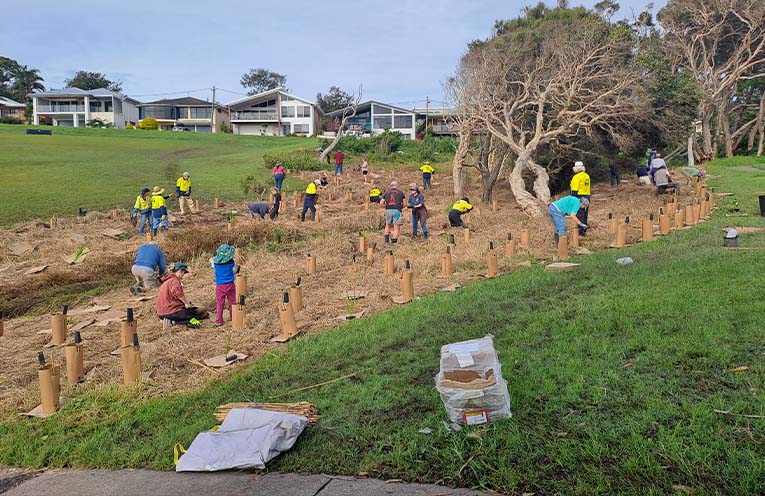MORE than 35 volunteers pitched in for a planting day at the historically significant “Tank Stream” at Bartlett Reserve, Bonny Hills on 25 May.
Around 300 shrubs and ground covers were planted as part of Stage One of the revegetation project, organised by Bonny Hills Landcare, Hastings Landcare and Port Macquarie-Hastings Council (PMHC).
Tank Stream holds a special place in the Bonny Hills story.
Replenished by a natural spring, the stream once served as a crucial water source for local Indigenous groups and early European settlers, including explorer John Oxley.
A reservoir was later constructed downstream at the cliff-face to supply fresh water.
The area is also linked to the official opening of Bonny Hills’ original post office and telephone exchange on 1 November 1948, just across from the stream’s source.
“This is about more than just planting natives,” said a Bonny Hills Landcare spokesperson.
“It’s about reviving an important part of our natural and cultural heritage while also creating a vital wildlife corridor.”
Ahead of the planting, Bonny Hills Landcare Group and PMHC prepared the site by controlling overgrown exotic grasses and weeds.
“PMHC have been a great help with site preparation and purchasing the plants,” Bonny Hills Landcare’s Ross Smith said.
The native groundcovers, shrubs and grasses planted were selected for their ability to attract insects, birds, reptiles and other wildlife, as well as prevent erosion.
“We planted a diversity of native plants including dianella, conjevoi, lomandra, callistemon and native ginger,” Hastings Landcare’s Robyn Camozzato said.
All the plants were grown from locally sourced seed at the Port Macquarie Landcare Nursery which is open to the public every Monday morning.
“It is great that Council can support such worthwhile events that bring the community together to enhance the local environment as well as cultural and historical sites,” said PMHC representative Dave Birrer.
The Bonny Hills Landcare Group plans to maintain the planting area as a part of their regular working bees.
When the planting is established, the group will extend the weed control and planting of natives right up to the road.




This collaborative approach is a classic example of what could be achieved at the Camden Head Pilot Station Reserve with local community groups, Council and Hastings Landcare working together. This reserve has a head start though as it is already regenerating to stunning, protected coastal rainforest, a threatened species, thanks to more than 25 years of volunteer effort. Will the newly formed Friends of Camden Head work with Landcare on preserving this site’s natural heritage? I hope so.